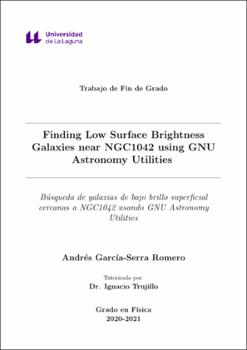Finding low surface brightness galaxies near NGC1042 using GNU astronomy utilities
Fecha
2021Resumen
This document describes the detection of Low Surface Brightness Galaxy (LSBG)
satellites around NGC1042 using the data obtained by the LBT Imaging of Galaxy
Halos and Tidal Structures (LIGHTS) survey. This survey has been recently proposed by a team of IAC researchers in collaboration with other institutes with the
objective of studying the low surface brightness universe for a better understanding on the behavior of galaxy stellar halos and the commonly known ”missing
satellites problem”. This last topic is the principal subject of this work. In collaboration with some members of the LIGHTS team, the project consisted of the
development of an algorithm capable of detecting these very low surface brightness objects. The document will start introducing the project and the data set
obtained, then the process of detection and categorization of the galaxies will be
explained, which will let to a final sample of these objects. Throughout the document some discussions will be made about the difficulties and challenges behind
the observation and detections of these very faint structures. For this analysis
some objects detected previously in the literature have been used as a reference. En este documento se presentan algunas candidatas a Galaxias de Bajo Brillo
Superficial (LSBG) alrededor de NGC1042 usando datos del cartografiado LBT
Imaging of Galaxy Halos and Tidal Structures (LIGHTS). Este cartografiado ha
sido propuesto recientemente por investigadores del IAC en colaboraci´on con otras
instituciones con el objetivo principal de estudiar el universo de bajo brillo superficial para entender m´as a fondo el comportamiento de halos estelares de galaxias
y el ”problema de los sat´elites perdidos”; siendo este ´ultimo el principal tema
por el que se desasrrolla este trabajo. En colaboraci´on con algunos miembros del
equipo de LIGHTS, el trabajo ha consistido en desarrollar un algoritmo capaz de
detectar estos objetos de muy bajo brillo superficial. Se comenzar´a el documento
introduciendo el proyecto y los datos obtenidos, despu´es se desarrollar´a el proceso
de detecci´on y categorizaci´on de estas galaxias, lo que llevar´a finalmente a un
muestreo de estas. Durante el proceso se discutir´an las dificultades y retos detr´as
de la observaci´on y detecci´on de estos objetos usando en todo momento como
referencia detecciones anteriores presentes en la bibliograf´ıa.





